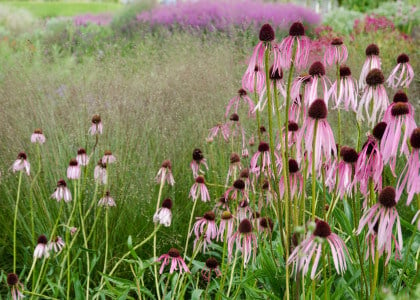Shortly after Halloween, DIY-Landscapers will pull out the shears, cut their perennials and grasses to the ground, and clear out the debris. Leaving themselves with a lifeless dirt bed to look at until next spring. Up to five months of looking at a winter desert where there was once a vibrant, thriving, flower bed.
THIS DOES NOT HAVE TO BE THE CASE!
We always encourage our customers to leave perennials and grasses up for the winter and prune them back to the ground in early spring.
Why?
Perennials and grasses have much to offer. These plants have color, texture, and unique seed pods that can provide a visually stimulating landscape, even in the winter months. They can also provide food and shelter for birds that may stick around for our cold, long winters.
General Tips to Keep in Mind for the Winter- As with all perennials, it is always best to clean up any foliage that was diseased this past growing season. Doing so will help eliminate re-infection next spring. Perennials love a fresh application of mulch in fall, as do most deciduous shrubs.
- Newly planted perennials, especially those newly planted in the fall, should be thoroughly mulched when planted around other plants. Also, mulch with evergreen boughs or marsh hay to prevent these plants from being heaved out of the ground by the freezing and thawing process. This is a necessary step to ensure good rooting in the fall and to help overwinter the best. This is the reason we recommend you stop installations of perennials by the end of October. This way the plants have a chance to root in before the ground freezes.
Below are some suggestions for winter handling of established perennials that we grow:
- Anemone - Cut back in fall or spring.
- Aster - Leave up for fall, cut back in spring.
- Astilbe - Leave up for fall if you like to see the dried flower heads, or cut back in fall or spring.
- Brunnera - Pull off dried foliage after frost kills it. (Prevents any leaf disease from overwintering on plants.)
- Butterfly Bush (a woody ornamental that is treated as a perennial here) - Cut back in spring only, please.
- Caryopteris (a woody ornamental that is treated as a perennial here) - Trim back in spring only, please.
- Catmint - Leave up for fall, cut back in spring.
- Columbine - Pull off dried foliage after frost kills it in either fall or early spring.
- Coneflower - Best cut-off in fall and remove all old foliage. (Prevents any leaf disease from overwintering on plants.)
- Coreopsis - Leave up for fall (important) and cut back in spring (they hate to be cut in fall).
- Daylily - Cut back and pull off all foliage in fall. (Prevents any leaf disease from overwintering on plants.)
- Fern - Leave up for fall, cut back in spring.
- Geranium - Cut back in fall or spring.
- Goldenrod - Leave up for fall if wanted, cut back in either fall or spring.
- Grasses - Please leave all up for fall and don't cut back until spring.
- Heuchera (Coral Bells) - Best if left alone until spring. In spring, pull off only dried leaves, don't cut way back.
- Hosta - Pull off old foliage after frost kills the leaves.
- Iris - Cut back in fall or spring.
- Ladysmantle - Cut back in fall or spring.
- Lungwort - Cut back in fall or very early spring.
- Peony - Cut back in fall.
- Phlox - Cut back in fall and remove all old foliage. (Prevents any leaf disease from overwintering on plants.)
- Rudbeckia - Cut back in fall or spring. (The seed heads are great little bird feeders, but if they had diseased foliage, it’s best to cut off and remove in fall.)
- Russian Sage - Cut back in spring.
- Salvia - Cut back in fall or spring.
- Sedum - Cut back in fall or spring. (Look great in winter if you leave the taller varieties up.)
- Veronica - Cut back in fall or spring.
- Woadwaxen - Cut back in spring-like you would a Spirea
In the meantime, pay attention to the landscapes you see this winter. Which ones are more interesting? The ones pruned to the ground, or the ones with ornamental grasses and perennials piercing the snow cover with a mosaic of textures.
To Learn More: Click Here

